Economics Assignment: Law of Demand, Supply, and 21st Century Theories
VerifiedAdded on 2023/01/05
|11
|3319
|76
Homework Assignment
AI Summary
This economics assignment delves into the fundamental principles of microeconomics, focusing on the law of demand and supply. It examines the factors that influence demand and supply curves, including movements and changes within these curves. The assignment also explores the relationship between 20th and 21st-century economic theories and models, particularly in the context of contemporary business practices. Furthermore, it discusses the impact of various factors, such as disposable income, prices of related goods, and technological advancements, on the shifts in demand and supply curves. The analysis includes real-world examples and discusses the evolution of economic thought, connecting classical economic principles with modern applications. The assignment also highlights the significance of understanding these concepts for comprehending market dynamics and business strategies.
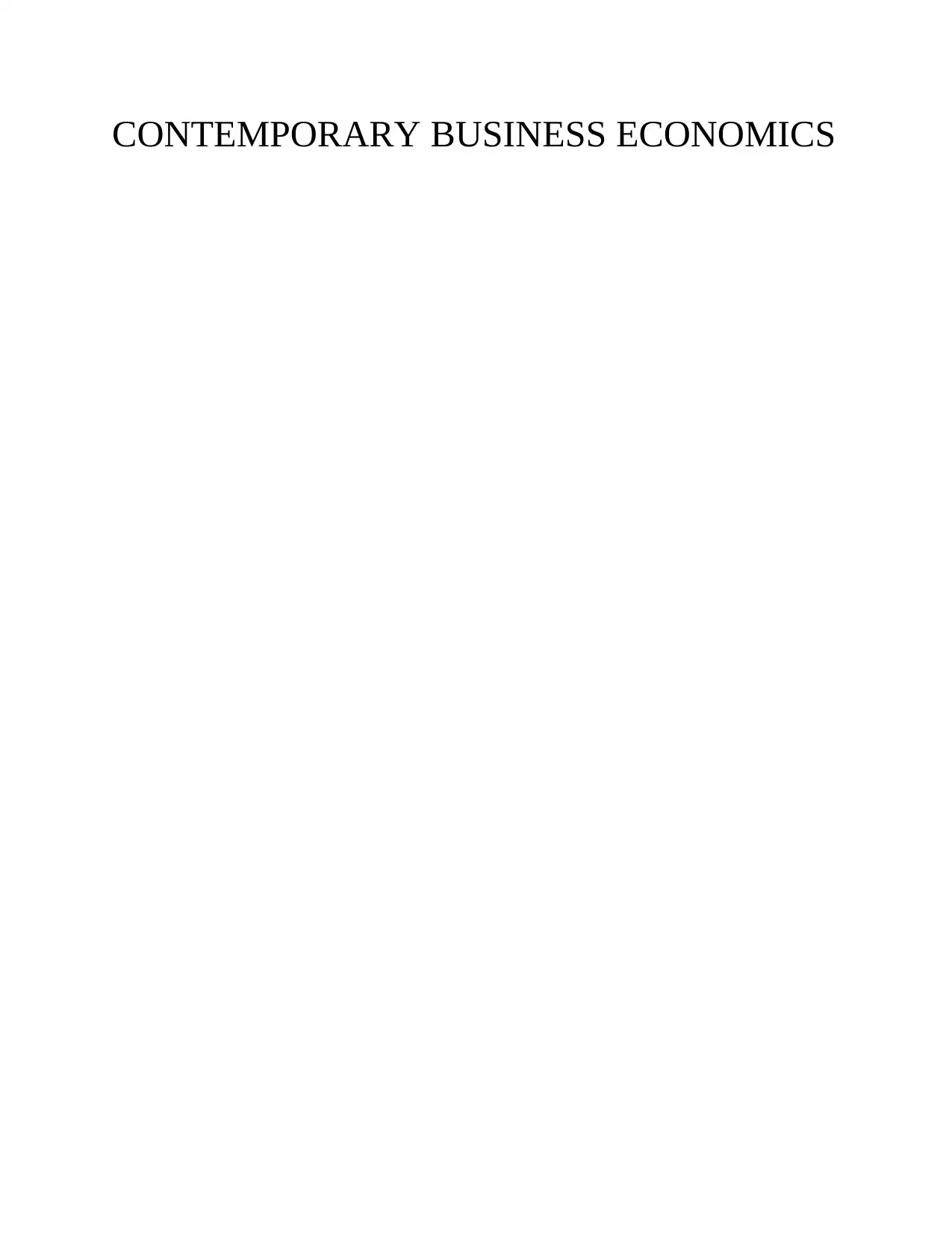
CONTEMPORARY BUSINESS ECONOMICS
Paraphrase This Document
Need a fresh take? Get an instant paraphrase of this document with our AI Paraphraser
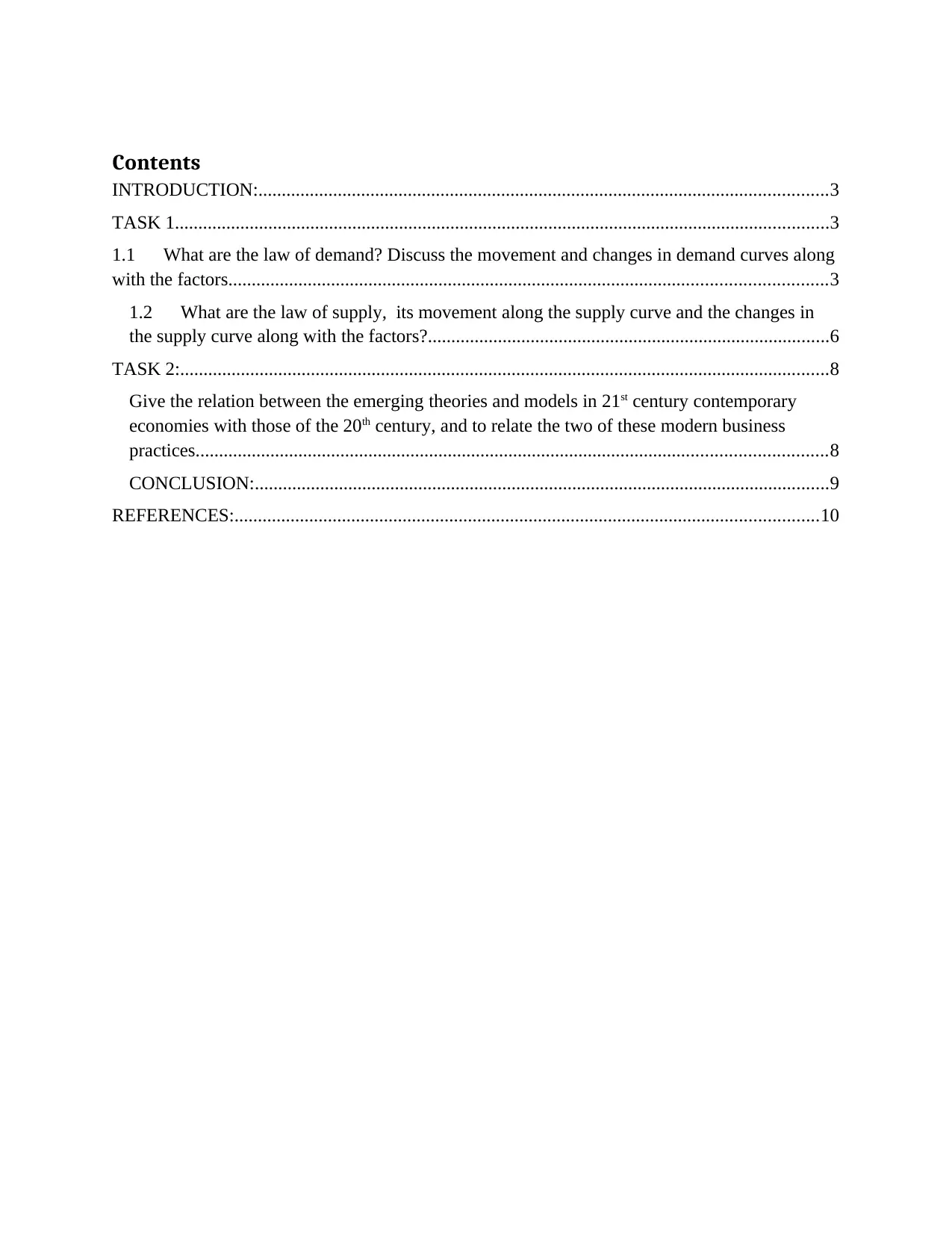
Contents
INTRODUCTION:..........................................................................................................................3
TASK 1............................................................................................................................................3
1.1 What are the law of demand? Discuss the movement and changes in demand curves along
with the factors................................................................................................................................3
1.2 What are the law of supply, its movement along the supply curve and the changes in
the supply curve along with the factors?......................................................................................6
TASK 2:...........................................................................................................................................8
Give the relation between the emerging theories and models in 21st century contemporary
economies with those of the 20th century, and to relate the two of these modern business
practices.......................................................................................................................................8
CONCLUSION:...........................................................................................................................9
REFERENCES:.............................................................................................................................10
INTRODUCTION:..........................................................................................................................3
TASK 1............................................................................................................................................3
1.1 What are the law of demand? Discuss the movement and changes in demand curves along
with the factors................................................................................................................................3
1.2 What are the law of supply, its movement along the supply curve and the changes in
the supply curve along with the factors?......................................................................................6
TASK 2:...........................................................................................................................................8
Give the relation between the emerging theories and models in 21st century contemporary
economies with those of the 20th century, and to relate the two of these modern business
practices.......................................................................................................................................8
CONCLUSION:...........................................................................................................................9
REFERENCES:.............................................................................................................................10
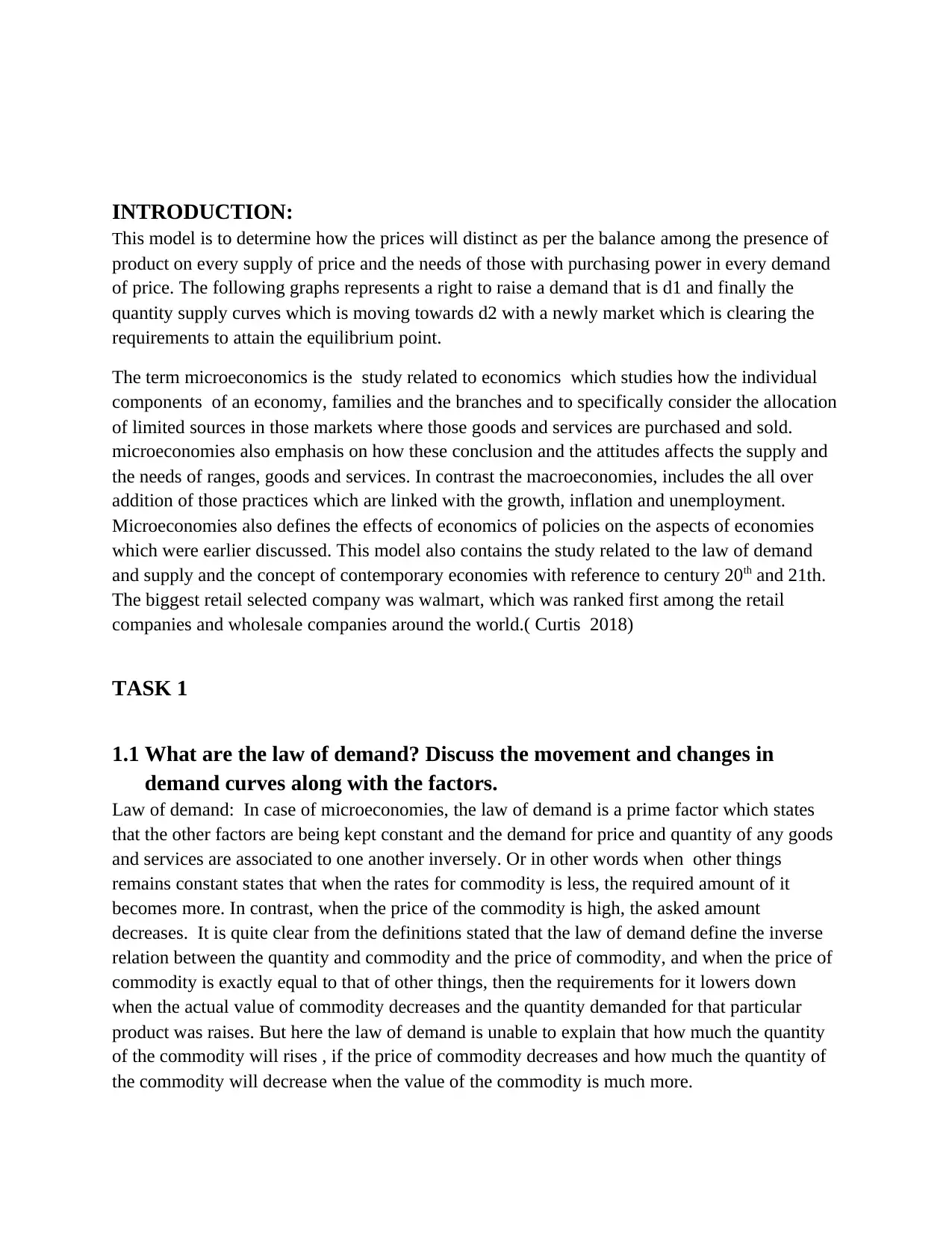
INTRODUCTION:
This model is to determine how the prices will distinct as per the balance among the presence of
product on every supply of price and the needs of those with purchasing power in every demand
of price. The following graphs represents a right to raise a demand that is d1 and finally the
quantity supply curves which is moving towards d2 with a newly market which is clearing the
requirements to attain the equilibrium point.
The term microeconomics is the study related to economics which studies how the individual
components of an economy, families and the branches and to specifically consider the allocation
of limited sources in those markets where those goods and services are purchased and sold.
microeconomies also emphasis on how these conclusion and the attitudes affects the supply and
the needs of ranges, goods and services. In contrast the macroeconomies, includes the all over
addition of those practices which are linked with the growth, inflation and unemployment.
Microeconomies also defines the effects of economics of policies on the aspects of economies
which were earlier discussed. This model also contains the study related to the law of demand
and supply and the concept of contemporary economies with reference to century 20th and 21th.
The biggest retail selected company was walmart, which was ranked first among the retail
companies and wholesale companies around the world.( Curtis 2018)
TASK 1
1.1 What are the law of demand? Discuss the movement and changes in
demand curves along with the factors.
Law of demand: In case of microeconomies, the law of demand is a prime factor which states
that the other factors are being kept constant and the demand for price and quantity of any goods
and services are associated to one another inversely. Or in other words when other things
remains constant states that when the rates for commodity is less, the required amount of it
becomes more. In contrast, when the price of the commodity is high, the asked amount
decreases. It is quite clear from the definitions stated that the law of demand define the inverse
relation between the quantity and commodity and the price of commodity, and when the price of
commodity is exactly equal to that of other things, then the requirements for it lowers down
when the actual value of commodity decreases and the quantity demanded for that particular
product was raises. But here the law of demand is unable to explain that how much the quantity
of the commodity will rises , if the price of commodity decreases and how much the quantity of
the commodity will decrease when the value of the commodity is much more.
This model is to determine how the prices will distinct as per the balance among the presence of
product on every supply of price and the needs of those with purchasing power in every demand
of price. The following graphs represents a right to raise a demand that is d1 and finally the
quantity supply curves which is moving towards d2 with a newly market which is clearing the
requirements to attain the equilibrium point.
The term microeconomics is the study related to economics which studies how the individual
components of an economy, families and the branches and to specifically consider the allocation
of limited sources in those markets where those goods and services are purchased and sold.
microeconomies also emphasis on how these conclusion and the attitudes affects the supply and
the needs of ranges, goods and services. In contrast the macroeconomies, includes the all over
addition of those practices which are linked with the growth, inflation and unemployment.
Microeconomies also defines the effects of economics of policies on the aspects of economies
which were earlier discussed. This model also contains the study related to the law of demand
and supply and the concept of contemporary economies with reference to century 20th and 21th.
The biggest retail selected company was walmart, which was ranked first among the retail
companies and wholesale companies around the world.( Curtis 2018)
TASK 1
1.1 What are the law of demand? Discuss the movement and changes in
demand curves along with the factors.
Law of demand: In case of microeconomies, the law of demand is a prime factor which states
that the other factors are being kept constant and the demand for price and quantity of any goods
and services are associated to one another inversely. Or in other words when other things
remains constant states that when the rates for commodity is less, the required amount of it
becomes more. In contrast, when the price of the commodity is high, the asked amount
decreases. It is quite clear from the definitions stated that the law of demand define the inverse
relation between the quantity and commodity and the price of commodity, and when the price of
commodity is exactly equal to that of other things, then the requirements for it lowers down
when the actual value of commodity decreases and the quantity demanded for that particular
product was raises. But here the law of demand is unable to explain that how much the quantity
of the commodity will rises , if the price of commodity decreases and how much the quantity of
the commodity will decrease when the value of the commodity is much more.
⊘ This is a preview!⊘
Do you want full access?
Subscribe today to unlock all pages.

Trusted by 1+ million students worldwide

Movement with the same demand curve
There are a series of factors which can state the quantity demanded which can clear out that the
demand curve is formulated on the basis of the determinants of the demand except the price
which remains unchanged. And then the question arises that what happens when one of the
determinants changes the question? The solution for this is to construct a new demand curve
which is if there is any variation caused in one determinants due to an other then it produces an
increase in demand. For example to increase in income the overall graph is shifted to right and in
contrary of each price, the demanded quantity will be much more. At the price p the quantity is
equal to q0 was demanded, and a quantity q1 is demanded and d1 is not particularly parallel to
d0. Instead of this variation of one of the other determinants request then causes a fall,that is the
curve will move to the left side. To make a difference between curve displacements and the
movements with the curve, the variation of the requirement function by the variation of the
quantity demanded. (Estola 2017 )
The formation in the interest bend takes place only when the ware activities coverts into both the
interest and the value, which makes the bend to move in a specific way. The formation of the
interest bend makes a change in to two parts for example the request for cost and amount , which
starts with one point then to the other. Then there are several things which remained unchanged
when the amount of interest changes due to the settlement of cost of an item or product, which
creates a major popular production with the bend and it can take place in following two ways
that is the upward development and the downward development.
There are a series of factors which can state the quantity demanded which can clear out that the
demand curve is formulated on the basis of the determinants of the demand except the price
which remains unchanged. And then the question arises that what happens when one of the
determinants changes the question? The solution for this is to construct a new demand curve
which is if there is any variation caused in one determinants due to an other then it produces an
increase in demand. For example to increase in income the overall graph is shifted to right and in
contrary of each price, the demanded quantity will be much more. At the price p the quantity is
equal to q0 was demanded, and a quantity q1 is demanded and d1 is not particularly parallel to
d0. Instead of this variation of one of the other determinants request then causes a fall,that is the
curve will move to the left side. To make a difference between curve displacements and the
movements with the curve, the variation of the requirement function by the variation of the
quantity demanded. (Estola 2017 )
The formation in the interest bend takes place only when the ware activities coverts into both the
interest and the value, which makes the bend to move in a specific way. The formation of the
interest bend makes a change in to two parts for example the request for cost and amount , which
starts with one point then to the other. Then there are several things which remained unchanged
when the amount of interest changes due to the settlement of cost of an item or product, which
creates a major popular production with the bend and it can take place in following two ways
that is the upward development and the downward development.
Paraphrase This Document
Need a fresh take? Get an instant paraphrase of this document with our AI Paraphraser
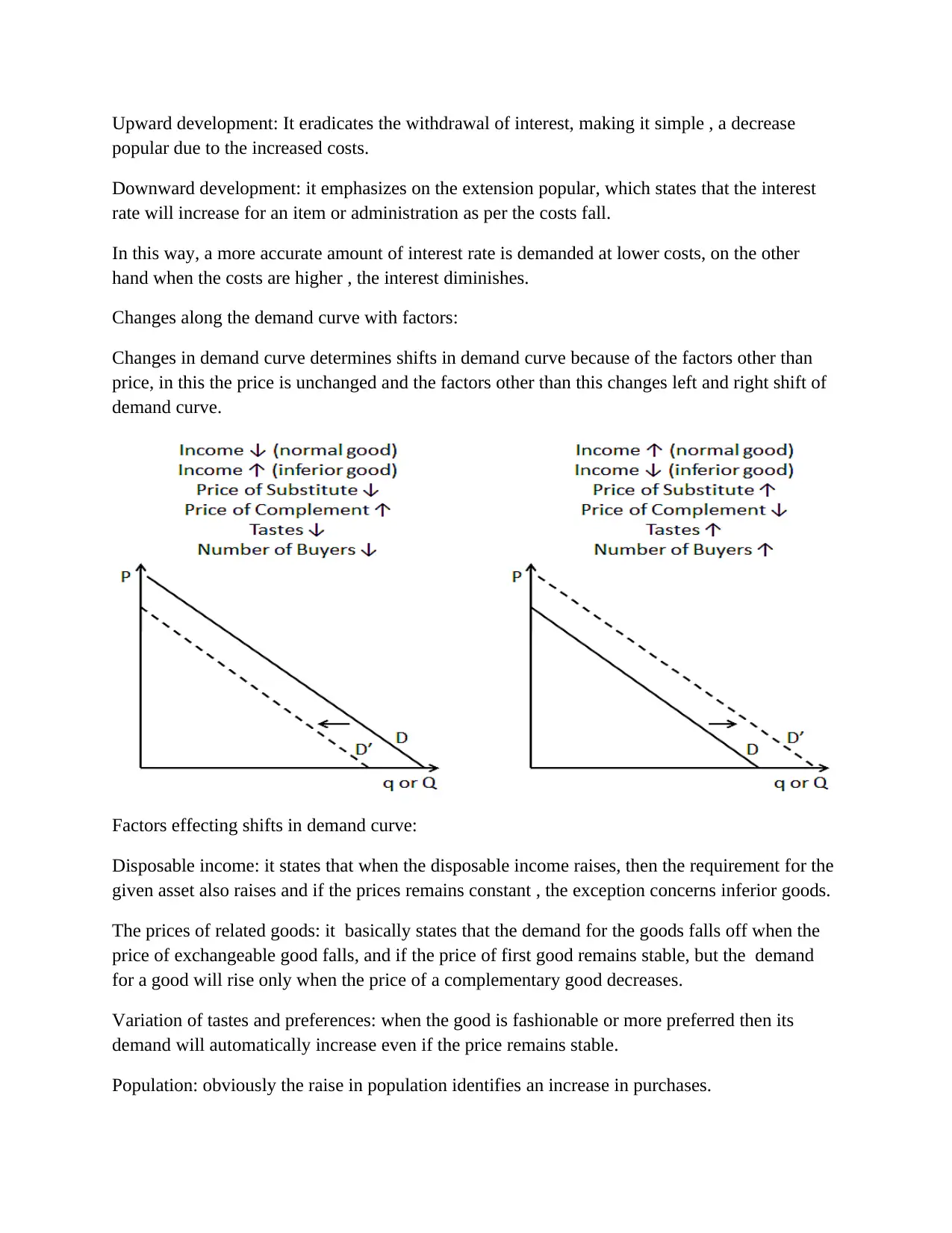
Upward development: It eradicates the withdrawal of interest, making it simple , a decrease
popular due to the increased costs.
Downward development: it emphasizes on the extension popular, which states that the interest
rate will increase for an item or administration as per the costs fall.
In this way, a more accurate amount of interest rate is demanded at lower costs, on the other
hand when the costs are higher , the interest diminishes.
Changes along the demand curve with factors:
Changes in demand curve determines shifts in demand curve because of the factors other than
price, in this the price is unchanged and the factors other than this changes left and right shift of
demand curve.
Factors effecting shifts in demand curve:
Disposable income: it states that when the disposable income raises, then the requirement for the
given asset also raises and if the prices remains constant , the exception concerns inferior goods.
The prices of related goods: it basically states that the demand for the goods falls off when the
price of exchangeable good falls, and if the price of first good remains stable, but the demand
for a good will rise only when the price of a complementary good decreases.
Variation of tastes and preferences: when the good is fashionable or more preferred then its
demand will automatically increase even if the price remains stable.
Population: obviously the raise in population identifies an increase in purchases.
popular due to the increased costs.
Downward development: it emphasizes on the extension popular, which states that the interest
rate will increase for an item or administration as per the costs fall.
In this way, a more accurate amount of interest rate is demanded at lower costs, on the other
hand when the costs are higher , the interest diminishes.
Changes along the demand curve with factors:
Changes in demand curve determines shifts in demand curve because of the factors other than
price, in this the price is unchanged and the factors other than this changes left and right shift of
demand curve.
Factors effecting shifts in demand curve:
Disposable income: it states that when the disposable income raises, then the requirement for the
given asset also raises and if the prices remains constant , the exception concerns inferior goods.
The prices of related goods: it basically states that the demand for the goods falls off when the
price of exchangeable good falls, and if the price of first good remains stable, but the demand
for a good will rise only when the price of a complementary good decreases.
Variation of tastes and preferences: when the good is fashionable or more preferred then its
demand will automatically increase even if the price remains stable.
Population: obviously the raise in population identifies an increase in purchases.

Particular influences: In the automotive sector, the presence of means of transport, cars security,
market expectations on the increase in prices in the short and long term.
If there is a distinction in any of these conditions, the demand curve shifts:
If there is an increase in demand at every price level then it indicates that the demand curve will
shift to right.
And if there is any decrease at any level of price then it will cause the demand curve to shift to
the left.
1.2 What are the law of supply, its movement along the supply curve and the
changes in the supply curve along with the factors?
Law of supply: The supply curve is the presentation of the economic offer of a good or service.
The supply curve is formed on the basis of a mathematical function in which the price is the
specific variable and at which the quantity of production of the goods depends upon. It is the
positive interaction between the quality which is supplied and the price and it is only the reason
for the upward slope of the supply curve. It means that the producers are trying to present more
of the goods for the sale on the market at expensive rates by raising the production as a way of
increasing the benefits. The supply curve hence can be a an increasing factor with the price. For
example, when the price is $ 1.00 the company’s price of production quantity is 100 units per
day and moreover more increase in sale price to $ 2.00 also encourages the company’s
production to rise the production value to 140 units per day.( Becchetti, Bruni, and Zamagni
2019 )
Due to the offer law the supply curve has a positive slope. According to the law of offer, if there
is an increase in quality offered to a goods or service there is an increase in price generated
thereafter and vice versa.
Movement along the supply curve:
If there is occurrence of any variation in the supply curve due to the rise and fall in price, while
taking other factors constant is termed as the movement along the supply curve. It is a one to one
relationship between the price and quantity supplied which emphasizes on the fact that the
quantity supply increases with the increase in price and decreases with the decrease in price of
the item. It represents the positive interaction between the two:
market expectations on the increase in prices in the short and long term.
If there is a distinction in any of these conditions, the demand curve shifts:
If there is an increase in demand at every price level then it indicates that the demand curve will
shift to right.
And if there is any decrease at any level of price then it will cause the demand curve to shift to
the left.
1.2 What are the law of supply, its movement along the supply curve and the
changes in the supply curve along with the factors?
Law of supply: The supply curve is the presentation of the economic offer of a good or service.
The supply curve is formed on the basis of a mathematical function in which the price is the
specific variable and at which the quantity of production of the goods depends upon. It is the
positive interaction between the quality which is supplied and the price and it is only the reason
for the upward slope of the supply curve. It means that the producers are trying to present more
of the goods for the sale on the market at expensive rates by raising the production as a way of
increasing the benefits. The supply curve hence can be a an increasing factor with the price. For
example, when the price is $ 1.00 the company’s price of production quantity is 100 units per
day and moreover more increase in sale price to $ 2.00 also encourages the company’s
production to rise the production value to 140 units per day.( Becchetti, Bruni, and Zamagni
2019 )
Due to the offer law the supply curve has a positive slope. According to the law of offer, if there
is an increase in quality offered to a goods or service there is an increase in price generated
thereafter and vice versa.
Movement along the supply curve:
If there is occurrence of any variation in the supply curve due to the rise and fall in price, while
taking other factors constant is termed as the movement along the supply curve. It is a one to one
relationship between the price and quantity supplied which emphasizes on the fact that the
quantity supply increases with the increase in price and decreases with the decrease in price of
the item. It represents the positive interaction between the two:
⊘ This is a preview!⊘
Do you want full access?
Subscribe today to unlock all pages.

Trusted by 1+ million students worldwide
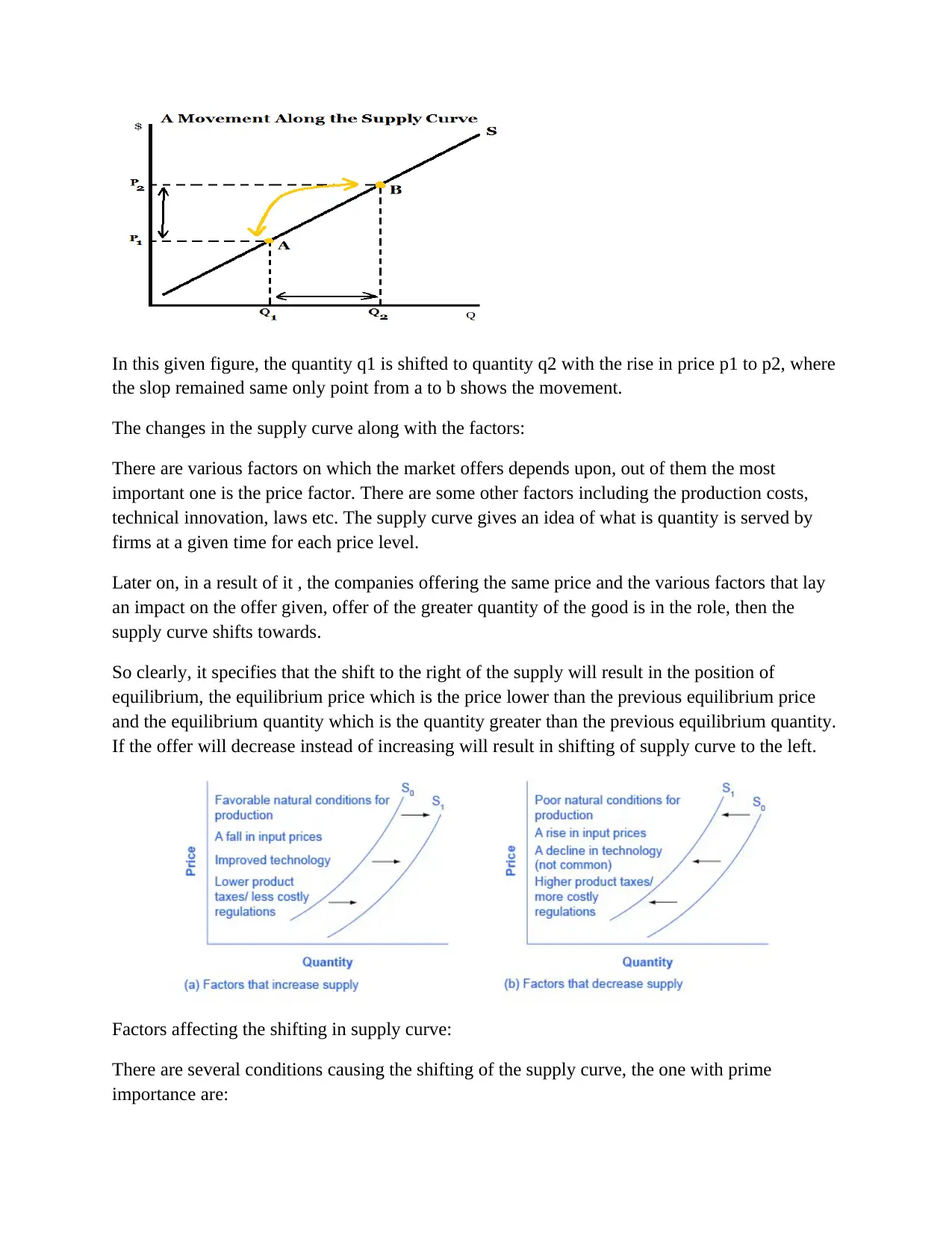
In this given figure, the quantity q1 is shifted to quantity q2 with the rise in price p1 to p2, where
the slop remained same only point from a to b shows the movement.
The changes in the supply curve along with the factors:
There are various factors on which the market offers depends upon, out of them the most
important one is the price factor. There are some other factors including the production costs,
technical innovation, laws etc. The supply curve gives an idea of what is quantity is served by
firms at a given time for each price level.
Later on, in a result of it , the companies offering the same price and the various factors that lay
an impact on the offer given, offer of the greater quantity of the good is in the role, then the
supply curve shifts towards.
So clearly, it specifies that the shift to the right of the supply will result in the position of
equilibrium, the equilibrium price which is the price lower than the previous equilibrium price
and the equilibrium quantity which is the quantity greater than the previous equilibrium quantity.
If the offer will decrease instead of increasing will result in shifting of supply curve to the left.
Factors affecting the shifting in supply curve:
There are several conditions causing the shifting of the supply curve, the one with prime
importance are:
the slop remained same only point from a to b shows the movement.
The changes in the supply curve along with the factors:
There are various factors on which the market offers depends upon, out of them the most
important one is the price factor. There are some other factors including the production costs,
technical innovation, laws etc. The supply curve gives an idea of what is quantity is served by
firms at a given time for each price level.
Later on, in a result of it , the companies offering the same price and the various factors that lay
an impact on the offer given, offer of the greater quantity of the good is in the role, then the
supply curve shifts towards.
So clearly, it specifies that the shift to the right of the supply will result in the position of
equilibrium, the equilibrium price which is the price lower than the previous equilibrium price
and the equilibrium quantity which is the quantity greater than the previous equilibrium quantity.
If the offer will decrease instead of increasing will result in shifting of supply curve to the left.
Factors affecting the shifting in supply curve:
There are several conditions causing the shifting of the supply curve, the one with prime
importance are:
Paraphrase This Document
Need a fresh take? Get an instant paraphrase of this document with our AI Paraphraser
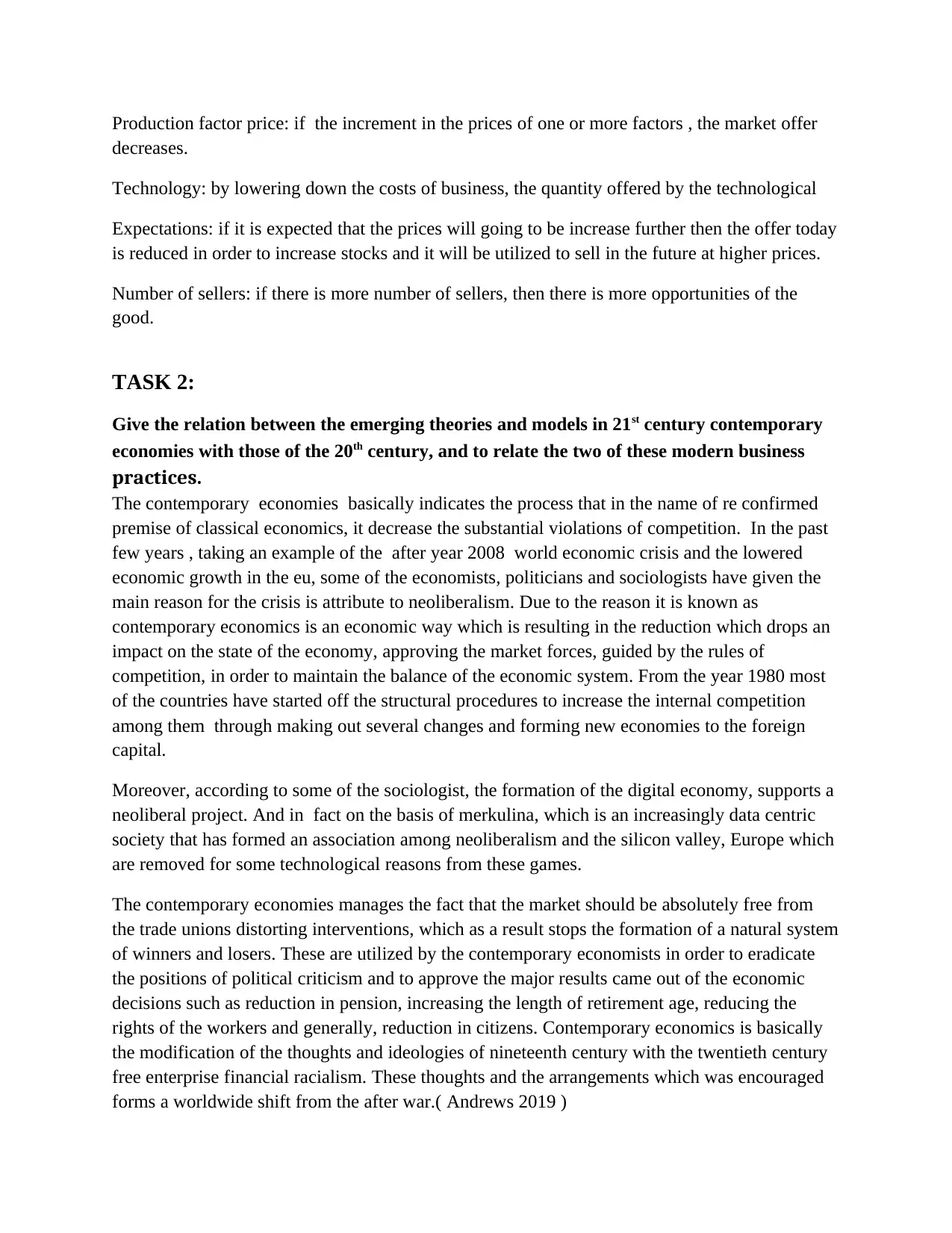
Production factor price: if the increment in the prices of one or more factors , the market offer
decreases.
Technology: by lowering down the costs of business, the quantity offered by the technological
Expectations: if it is expected that the prices will going to be increase further then the offer today
is reduced in order to increase stocks and it will be utilized to sell in the future at higher prices.
Number of sellers: if there is more number of sellers, then there is more opportunities of the
good.
TASK 2:
Give the relation between the emerging theories and models in 21st century contemporary
economies with those of the 20th century, and to relate the two of these modern business
practices.
The contemporary economies basically indicates the process that in the name of re confirmed
premise of classical economics, it decrease the substantial violations of competition. In the past
few years , taking an example of the after year 2008 world economic crisis and the lowered
economic growth in the eu, some of the economists, politicians and sociologists have given the
main reason for the crisis is attribute to neoliberalism. Due to the reason it is known as
contemporary economics is an economic way which is resulting in the reduction which drops an
impact on the state of the economy, approving the market forces, guided by the rules of
competition, in order to maintain the balance of the economic system. From the year 1980 most
of the countries have started off the structural procedures to increase the internal competition
among them through making out several changes and forming new economies to the foreign
capital.
Moreover, according to some of the sociologist, the formation of the digital economy, supports a
neoliberal project. And in fact on the basis of merkulina, which is an increasingly data centric
society that has formed an association among neoliberalism and the silicon valley, Europe which
are removed for some technological reasons from these games.
The contemporary economies manages the fact that the market should be absolutely free from
the trade unions distorting interventions, which as a result stops the formation of a natural system
of winners and losers. These are utilized by the contemporary economists in order to eradicate
the positions of political criticism and to approve the major results came out of the economic
decisions such as reduction in pension, increasing the length of retirement age, reducing the
rights of the workers and generally, reduction in citizens. Contemporary economics is basically
the modification of the thoughts and ideologies of nineteenth century with the twentieth century
free enterprise financial racialism. These thoughts and the arrangements which was encouraged
forms a worldwide shift from the after war.( Andrews 2019 )
decreases.
Technology: by lowering down the costs of business, the quantity offered by the technological
Expectations: if it is expected that the prices will going to be increase further then the offer today
is reduced in order to increase stocks and it will be utilized to sell in the future at higher prices.
Number of sellers: if there is more number of sellers, then there is more opportunities of the
good.
TASK 2:
Give the relation between the emerging theories and models in 21st century contemporary
economies with those of the 20th century, and to relate the two of these modern business
practices.
The contemporary economies basically indicates the process that in the name of re confirmed
premise of classical economics, it decrease the substantial violations of competition. In the past
few years , taking an example of the after year 2008 world economic crisis and the lowered
economic growth in the eu, some of the economists, politicians and sociologists have given the
main reason for the crisis is attribute to neoliberalism. Due to the reason it is known as
contemporary economics is an economic way which is resulting in the reduction which drops an
impact on the state of the economy, approving the market forces, guided by the rules of
competition, in order to maintain the balance of the economic system. From the year 1980 most
of the countries have started off the structural procedures to increase the internal competition
among them through making out several changes and forming new economies to the foreign
capital.
Moreover, according to some of the sociologist, the formation of the digital economy, supports a
neoliberal project. And in fact on the basis of merkulina, which is an increasingly data centric
society that has formed an association among neoliberalism and the silicon valley, Europe which
are removed for some technological reasons from these games.
The contemporary economies manages the fact that the market should be absolutely free from
the trade unions distorting interventions, which as a result stops the formation of a natural system
of winners and losers. These are utilized by the contemporary economists in order to eradicate
the positions of political criticism and to approve the major results came out of the economic
decisions such as reduction in pension, increasing the length of retirement age, reducing the
rights of the workers and generally, reduction in citizens. Contemporary economics is basically
the modification of the thoughts and ideologies of nineteenth century with the twentieth century
free enterprise financial racialism. These thoughts and the arrangements which was encouraged
forms a worldwide shift from the after war.( Andrews 2019 )
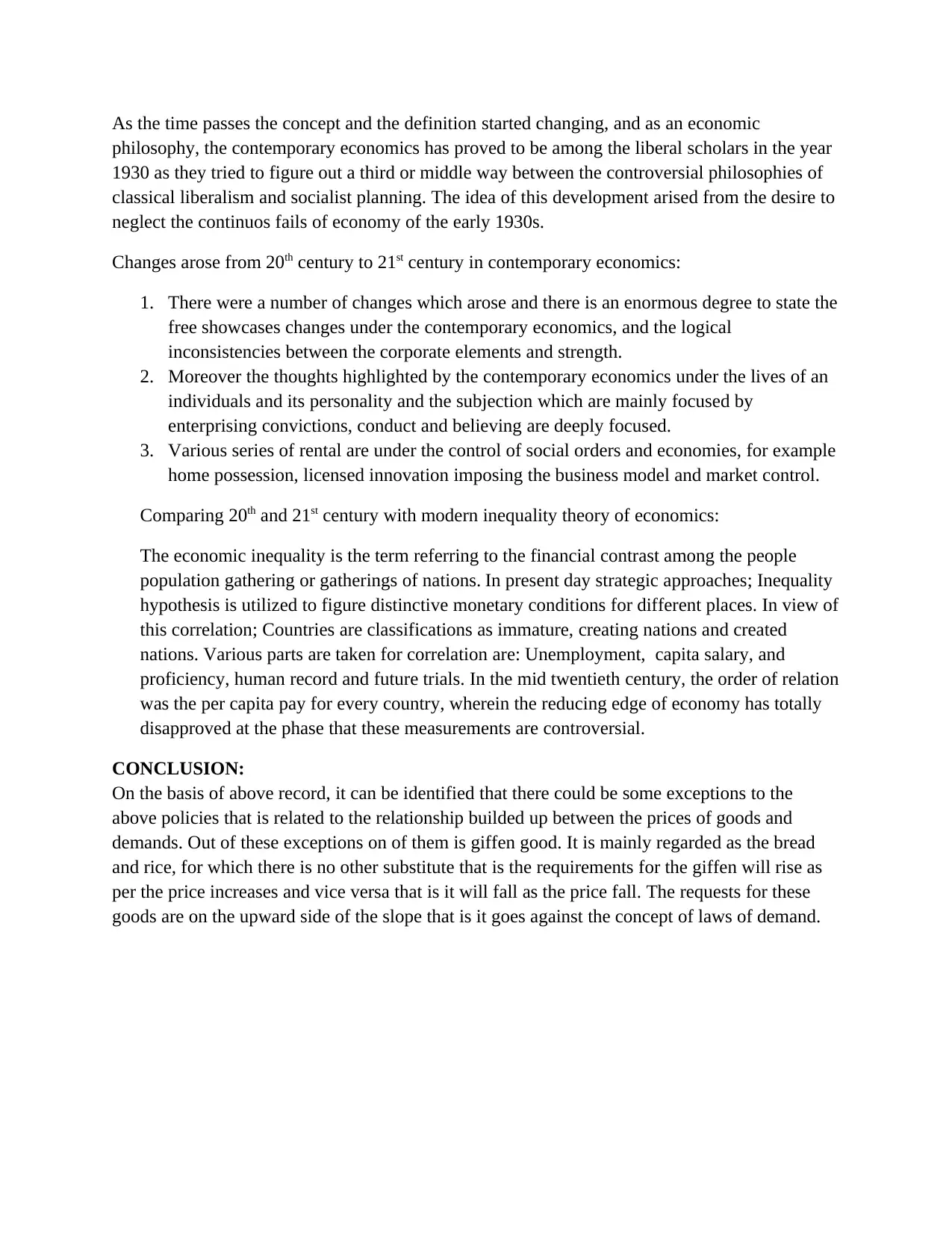
As the time passes the concept and the definition started changing, and as an economic
philosophy, the contemporary economics has proved to be among the liberal scholars in the year
1930 as they tried to figure out a third or middle way between the controversial philosophies of
classical liberalism and socialist planning. The idea of this development arised from the desire to
neglect the continuos fails of economy of the early 1930s.
Changes arose from 20th century to 21st century in contemporary economics:
1. There were a number of changes which arose and there is an enormous degree to state the
free showcases changes under the contemporary economics, and the logical
inconsistencies between the corporate elements and strength.
2. Moreover the thoughts highlighted by the contemporary economics under the lives of an
individuals and its personality and the subjection which are mainly focused by
enterprising convictions, conduct and believing are deeply focused.
3. Various series of rental are under the control of social orders and economies, for example
home possession, licensed innovation imposing the business model and market control.
Comparing 20th and 21st century with modern inequality theory of economics:
The economic inequality is the term referring to the financial contrast among the people
population gathering or gatherings of nations. In present day strategic approaches; Inequality
hypothesis is utilized to figure distinctive monetary conditions for different places. In view of
this correlation; Countries are classifications as immature, creating nations and created
nations. Various parts are taken for correlation are: Unemployment, capita salary, and
proficiency, human record and future trials. In the mid twentieth century, the order of relation
was the per capita pay for every country, wherein the reducing edge of economy has totally
disapproved at the phase that these measurements are controversial.
CONCLUSION:
On the basis of above record, it can be identified that there could be some exceptions to the
above policies that is related to the relationship builded up between the prices of goods and
demands. Out of these exceptions on of them is giffen good. It is mainly regarded as the bread
and rice, for which there is no other substitute that is the requirements for the giffen will rise as
per the price increases and vice versa that is it will fall as the price fall. The requests for these
goods are on the upward side of the slope that is it goes against the concept of laws of demand.
philosophy, the contemporary economics has proved to be among the liberal scholars in the year
1930 as they tried to figure out a third or middle way between the controversial philosophies of
classical liberalism and socialist planning. The idea of this development arised from the desire to
neglect the continuos fails of economy of the early 1930s.
Changes arose from 20th century to 21st century in contemporary economics:
1. There were a number of changes which arose and there is an enormous degree to state the
free showcases changes under the contemporary economics, and the logical
inconsistencies between the corporate elements and strength.
2. Moreover the thoughts highlighted by the contemporary economics under the lives of an
individuals and its personality and the subjection which are mainly focused by
enterprising convictions, conduct and believing are deeply focused.
3. Various series of rental are under the control of social orders and economies, for example
home possession, licensed innovation imposing the business model and market control.
Comparing 20th and 21st century with modern inequality theory of economics:
The economic inequality is the term referring to the financial contrast among the people
population gathering or gatherings of nations. In present day strategic approaches; Inequality
hypothesis is utilized to figure distinctive monetary conditions for different places. In view of
this correlation; Countries are classifications as immature, creating nations and created
nations. Various parts are taken for correlation are: Unemployment, capita salary, and
proficiency, human record and future trials. In the mid twentieth century, the order of relation
was the per capita pay for every country, wherein the reducing edge of economy has totally
disapproved at the phase that these measurements are controversial.
CONCLUSION:
On the basis of above record, it can be identified that there could be some exceptions to the
above policies that is related to the relationship builded up between the prices of goods and
demands. Out of these exceptions on of them is giffen good. It is mainly regarded as the bread
and rice, for which there is no other substitute that is the requirements for the giffen will rise as
per the price increases and vice versa that is it will fall as the price fall. The requests for these
goods are on the upward side of the slope that is it goes against the concept of laws of demand.
⊘ This is a preview!⊘
Do you want full access?
Subscribe today to unlock all pages.

Trusted by 1+ million students worldwide

REFERENCES:
Books and journals:
Andrews, T.P., 2019. Econ FilmMaking: an experiential, problem-based, multimedia project for
microeconomics. International Journal of Pluralism and Economics Education, 10(3),
pp.288-302.
Becchetti, L., Bruni, L. and Zamagni, S., 2019. The Microeconomics of Wellbeing and
Sustainability: Recasting the Economic Process. Academic Press.
Cherrier, B., 2017. Classifying economics: A history of the JEL codes. Journal of economic
literature, 55(2), pp.545-79.
Currie, D., Peel, D. and Peters, W. eds., 2016. Microeconomic Analysis (Routledge Revivals):
Essays in Microeconomics and Economic Development. Routledge.
Curtis Jr, J., 2018. Economics: A Student Textbook and Professor Manual for University
Instruction of Microeconomics Courses. Scholars' Press.
Deng, J., Wang, H.B., Wang, C.M. and Zhang, G.W., 2017. A novel power market clearing
model based on the equilibrium principle in microeconomics. Journal of Cleaner
Production, 142, pp.1021-1027.
Estola, M., 2017. Newtonian microeconomics: A dynamic extension to neoclassical micro theory.
Springer.
Kolmar, M., 2017. Principles of Microeconomics. Springer International Publishing.
Lin, T.C., 2018. Using classroom game play in introductory microeconomics to enhance
business student learning and lecture attendance. Journal of Education for
Business, 93(7), pp.295-303.
Merkulina, I.A. and Kazakova, A.V., 2017. Reserves of increasing efficiency of industrial
enterprisesin context of contemporary economics. Russian Journal of Industrial
Economics.
Nechyba, T.J., 2019. What should students learn in intermediate microeconomics? To think
conceptually from the fundamentals of the discipline. The Journal of Economic
Education, 50(3), pp.261-264.
Nerlove, M. ed., 2016. Issues in Contemporary Economics: Volume 2: Macroeconomics and
Econometrics. Springer.
Nermend, K. and Łatuszyńska, M., 2020. Experimental and Quantitative Methods in
Contemporary Economics. Springer.
Ofurum, U.A. and Gabriel, J.M.O., 2019. Multidimensional Ethical Dilemmas of Contemporary
Organizations: A Literature Review. International Journal of Innovation and Economic
Development, 5(3), pp.7-18.
Stoneman, P. and Bartoloni, E., 2018. The microeconomics of product innovation. Oxford
University Press.
Sutanto, D.N., 2018. THE NATURE OF LITERARY STUDY AFTER THE RISE OF
CONTEMPORARY LITERARY THEORY. International Journal of Humanity Studies
(IJHS), 2(1), pp.82-89.
Volchkova, N. and Turdyeva, N., 2016. Microeconomics of Russian import substitution. Journal
of the New Economic Association, 32(4), pp.140-146.
Books and journals:
Andrews, T.P., 2019. Econ FilmMaking: an experiential, problem-based, multimedia project for
microeconomics. International Journal of Pluralism and Economics Education, 10(3),
pp.288-302.
Becchetti, L., Bruni, L. and Zamagni, S., 2019. The Microeconomics of Wellbeing and
Sustainability: Recasting the Economic Process. Academic Press.
Cherrier, B., 2017. Classifying economics: A history of the JEL codes. Journal of economic
literature, 55(2), pp.545-79.
Currie, D., Peel, D. and Peters, W. eds., 2016. Microeconomic Analysis (Routledge Revivals):
Essays in Microeconomics and Economic Development. Routledge.
Curtis Jr, J., 2018. Economics: A Student Textbook and Professor Manual for University
Instruction of Microeconomics Courses. Scholars' Press.
Deng, J., Wang, H.B., Wang, C.M. and Zhang, G.W., 2017. A novel power market clearing
model based on the equilibrium principle in microeconomics. Journal of Cleaner
Production, 142, pp.1021-1027.
Estola, M., 2017. Newtonian microeconomics: A dynamic extension to neoclassical micro theory.
Springer.
Kolmar, M., 2017. Principles of Microeconomics. Springer International Publishing.
Lin, T.C., 2018. Using classroom game play in introductory microeconomics to enhance
business student learning and lecture attendance. Journal of Education for
Business, 93(7), pp.295-303.
Merkulina, I.A. and Kazakova, A.V., 2017. Reserves of increasing efficiency of industrial
enterprisesin context of contemporary economics. Russian Journal of Industrial
Economics.
Nechyba, T.J., 2019. What should students learn in intermediate microeconomics? To think
conceptually from the fundamentals of the discipline. The Journal of Economic
Education, 50(3), pp.261-264.
Nerlove, M. ed., 2016. Issues in Contemporary Economics: Volume 2: Macroeconomics and
Econometrics. Springer.
Nermend, K. and Łatuszyńska, M., 2020. Experimental and Quantitative Methods in
Contemporary Economics. Springer.
Ofurum, U.A. and Gabriel, J.M.O., 2019. Multidimensional Ethical Dilemmas of Contemporary
Organizations: A Literature Review. International Journal of Innovation and Economic
Development, 5(3), pp.7-18.
Stoneman, P. and Bartoloni, E., 2018. The microeconomics of product innovation. Oxford
University Press.
Sutanto, D.N., 2018. THE NATURE OF LITERARY STUDY AFTER THE RISE OF
CONTEMPORARY LITERARY THEORY. International Journal of Humanity Studies
(IJHS), 2(1), pp.82-89.
Volchkova, N. and Turdyeva, N., 2016. Microeconomics of Russian import substitution. Journal
of the New Economic Association, 32(4), pp.140-146.
Paraphrase This Document
Need a fresh take? Get an instant paraphrase of this document with our AI Paraphraser
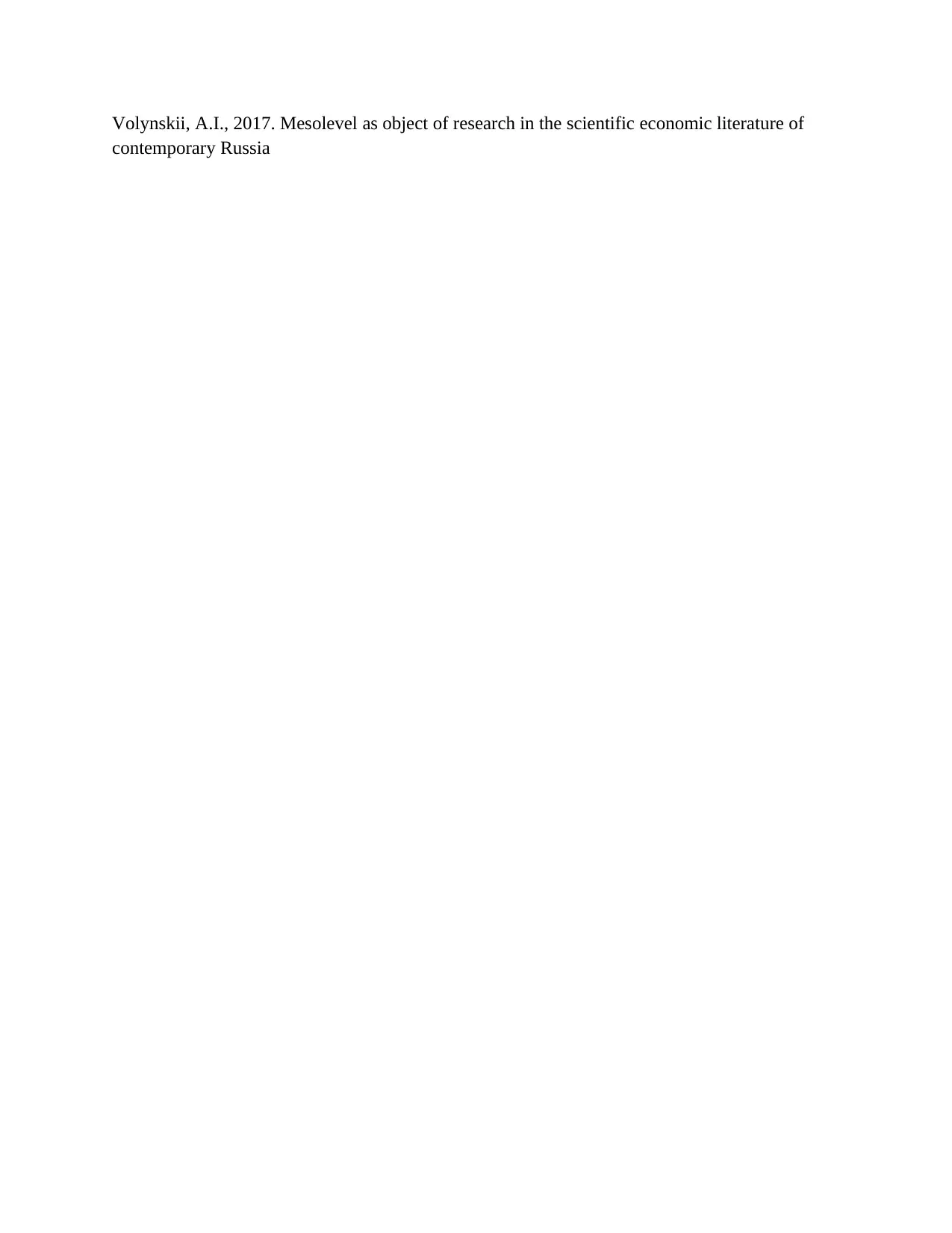
Volynskii, A.I., 2017. Mesolevel as object of research in the scientific economic literature of
contemporary Russia
contemporary Russia
1 out of 11
Related Documents
Your All-in-One AI-Powered Toolkit for Academic Success.
+13062052269
info@desklib.com
Available 24*7 on WhatsApp / Email
![[object Object]](/_next/static/media/star-bottom.7253800d.svg)
Unlock your academic potential
Copyright © 2020–2025 A2Z Services. All Rights Reserved. Developed and managed by ZUCOL.



